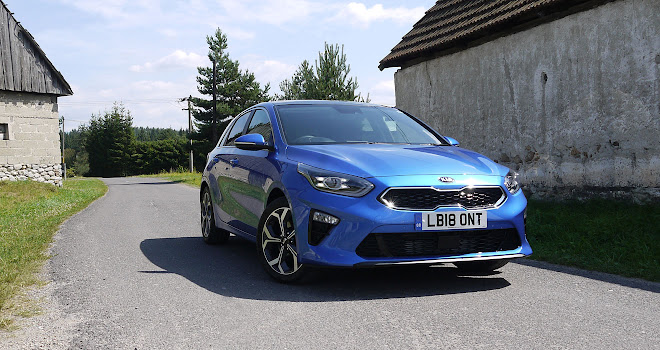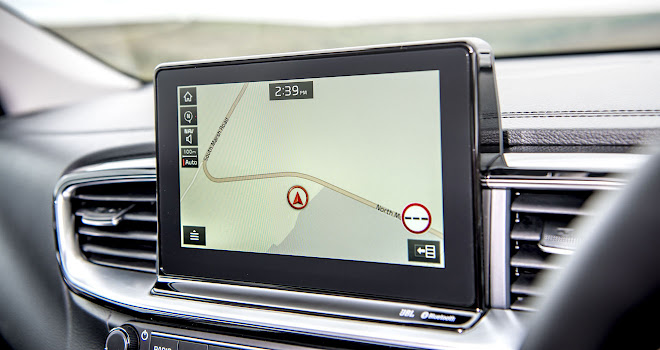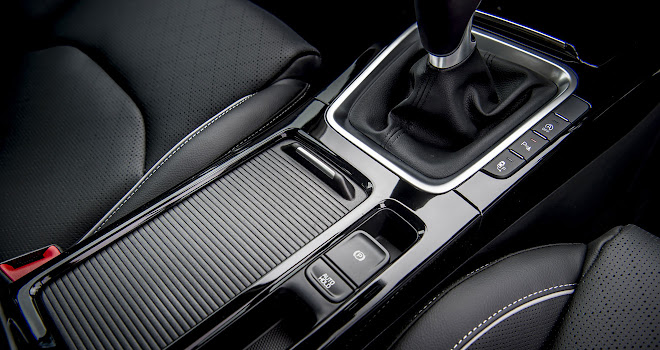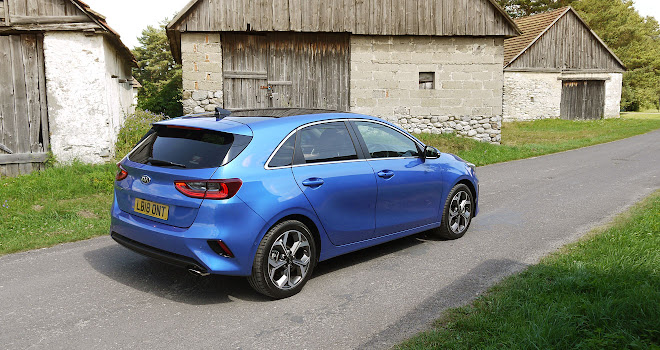
Rating: stars
Good: Long warranty, quiet cabin, plenty of kit
Bad: Anonymous looks, disappointing fuel economy
Price: from £18,295 – the version reviewed costs £25,750
Kia’s sensible Ceed first appeared in 2006, along with a not very sensible name. Cee-apostrophe-d always seemed like a particularly daft thing to call such an unfussy car, so the more straightforward spelling that arrives along with the new third-generation car is more than welcome.
Considerably less silly than the old spelling was the seven-year warranty that arrived with the first generation Ceed, a level of cover that continues to provide a very strong incentive to choose the Korean car over a Ford Focus or Renault Mégane.
I say Korean, but in reality the Ceed is a thoroughly international effort – assembled in Slovakia to a German design on a platform engineered in Korea. This global division of labour has clearly worked well, because the new Ceed immediately strikes as a well thought out, solid piece of kit, though the German design team might possibly have let the side down a bit. They have come up with a shape that your eyes tend to slide over without sticking. I can’t imagine throwing too many backward glances across the car park if I were to become a new Ceed owner.

Happily there is more to motoring than seductive good looks. That long warranty, for example, is bound to foster warm feelings.
Guaranteeing that nothing major will fall apart for seven years is a fairly big deal – and one that makes business sense only if you build a car to last. The Ceed does indeed feel as if it will shrug off a lot of hard use, though my two days of tests in Slovakia, near the Kia factory, can hardly be called exhaustive. But it’s fair to say the Ceed shrugged off some lumpy, bumpy roads and nothing rattled or shook or grated or snapped off in my hand.
The new Ceed is about 2cm wider and 2cm lower than the second-generation car it replaces, but measures exactly the same 4.31 metres from nose to tail. Kia seems to be resisting the usual trend for cars to get bigger and bigger with every revamp, and as a result the new Ceed is about 7cm shorter than the latest Focus.

The new cabin looks suitably up to date, with its seven or eight-inch touchscreen jutting up from the middle of the dashboard – a position that is fast becoming the standard arrangement. The layout brings the screen close to the driver’s eye level while still letting the rest of the dashboard fall away, creating a more spacious impression.
Kia has given its cockpit a slight sporty feel by angling the touchscreen towards the driver and by setting the twin dials of the instrument cluster behind dramatically canted glass. The instruments feel as if they are trying to wrap around the driver.
Despite the big touchscreen, quite a lot of hardware buttons, knobs and switches remain, ranked in two layers beneath the display. Top spec variants gain a third tier of buttons for controlling heated and ventilated seats, and a heated steering wheel. Three tiers of buttons can look a little untidy, though it does mean you can enjoy all the bells and whistles on offer.

Four trim levels are currently offered in the UK, called ‘2’, ‘Blue Edition’, ‘3’ and ‘First Edition’.
All four trim levels feature fancy “ice cube” LEDs, arranged in a square within the headlamps, giving the daytime running lights the look of a cut-price Porsche. At the back, the kidney-shaped clusters also light up in the daytime, outlined in pinstriped red. Full LED headlamps are fitted to Blue Edition and First Edition cars.
There’s a good level of infotainment support, with Android Auto and Apple CarPlay fully supported, including voice interaction. Two 12-volt sockets nestle in a handy cubby at the front of the centre console, alongside a USB socket and aux-in connector. A DAB radio and Bluetooth streaming support are standard throughout the range, while First Edition models gain a Qi wireless charging tray and eight-speaker JBL audio upgrade. All models provide a reversing camera.

You’ll still find a traditional handbrake lever in most models of Ceed. Upper trim levels get the option of an electronic parking brake with an auto option to hold the car whenever it stops.
On the road, the car provides no surprises good or bad. It felt quiet and smooth over the poorly maintained sections of our test route, with some of the worst stretches of Slovakian mountain tarmac doing a fine impression of Great Britain’s average thoroughfare.
The most impressive engine I sampled was a 138bhp, 1.4-litre T-GDi (turbocharged gasoline direct injection) four-cylinder unit. It seemed almost eerily quiet, but was able to waft the Ceed to 60mph in 8.9 seconds. It was only when I rolled down my window that I truly appreciated how much effort Kia must have put into cabin refinement – the noise actually emerging from the tailpipe is surprisingly throaty.

Even more insulation might not go amiss in the diesel variant, with no shortage of moaning growls making their way aboard from the three-cylinder, 118bhp, 1.0-litre T-GDi engine I tried.
Kia’s standard six-speed manual transmission provided a pleasant surprise, with a short, neat and crisp action worthy of a much more sporty car. A seven-speed dual-clutch automatic gearbox is an option with the 1.4 petrol and 1.6-litre diesel engines, though I haven’t tried it.

Alas that also meant I wasn’t able to try Kia’s clever-sounding Lane Following Assist technology, which takes care of steering, braking and acceleration on dual carriageways at up to 81mph in upper-end automatic models.
I was able to try a haptic lane-keeping feature fitted to other Ceed variants. It will give the steering a fairly firm tug if you stray over a white line without indicating. These nudges are not always welcome and happily in the Ceed they can be switched off, but I left the system active and found it reasonably sensible – and preferable to most of its ilk. At least it didn’t keep beeping idiotically on a B-road.

Prices for the new Ceed start at £18,295, which buys the ‘2’ trim level with manual gearbox and 1.0-litre petrol engine. Versions with the appealing 1.4-litre T-GDi petrol engine start at £21,095.
Not all economy figures were finalised at the time of writing. Those that are available tend towards the mediocre, alas, with a 1.4-litre petrol car with 7-speed dual-clutch gearbox rated at 50.4mpg on the combined cycle, with a 127g/km rating. Something below 120g/km would have been a more welcome result.
Overall, the new Ceed is a bit bland to look at, but represents a stride forward in interior comfort and refinement for Kia, with plenty of up-to-date technology freshly installed on board. But I suspect it’s that seven-year warranty that will prove the biggest draw.




